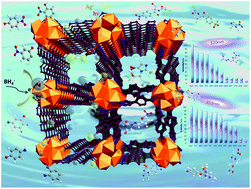The highly selective detecting of antibiotics and support of noble metal catalysts by a multifunctional Eu-MOF†
Abstract
Designing novel multifunctional rare-earth metal–organic frameworks (MOFs) has attracted intensive attention. In particular, employing such materials for sensing or catalytic reactions is still very challenging. Here, a new 3D porous Eu(III)-MOF, [Eu(cppa)(OH)]·xS (denoted as CTGU-19, S = solvent molecule, CTGU = China Three Gorges University), was synthesized by using 5-(4-carboxyphenyl)picolinic acid (H2cppa) as an organic ligand, and it shows a 3D (3,12)-connected topological net with the point symbol (420·628·818)(43)4, constructed from cubane-shaped tetranuclear europium building units. Interestingly, CTGU-19 can be used as a highly sensitive luminescent sensor to identify ornidazole (ODZ) and nitrofurantoin (NFT) at different excitation wavelengths. This result represents the first example of a lanthanide-metal–organic-framework (Eu-MOF) that can be employed as a discriminating fluorescent probe to recognize ODZ and NFT at different excitation wavelengths. Furthermore, after loading CTGU-19 with Ag and/or Au nanoparticles, the composites exhibit efficient catalytic performance for reducing 2-/3-/4-nitrophenols (2-/3-/4-NP), in which the unit mass reduction rate constants of Ag0.8Au0.2@CTGU-19 for 2-NP, 3-NP, and 4-NP reach 68.8, 53.80, and 52.34 s−1 g−1, respectively.



 Please wait while we load your content...
Please wait while we load your content...